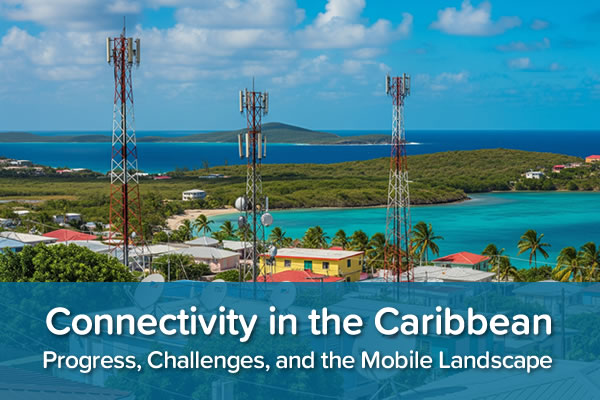The latest news and insights

Connectivity in the Caribbean: Progress, Challenges, and the Mobile Landscape
The Caribbean region has seen notable progress in digital connectivity over the past decade, with high-speed internet coverage expanding significantly and mobile networks becoming more robust. Despite these advances, nearly half of the population in the Caribbean islands remains unconnected, and there are persistent challenges related to affordability, digital skills, and infrastructure. Universal Service Funds have helped extend coverage, but gaps in usage and quality remain, especially in rural and underserved areas.
Mobile Communications: Growth and Gaps
Mobile connectivity is a cornerstone of the region’s digital transformation. As of 2022, the Caribbean had 28 million unique mobile subscribers, representing a market penetration of 63.7%—slightly below the global average of 67.1%. The number of mobile connections often exceeds the population due to the use of multiple SIMs and eSIMs for personal and business purposes, as seen in markets like Aruba and the British Virgin Islands, where mobile connections reach 132% and 143% of the total population, respectively. However, having a mobile connection does not always mean access to mobile data or broadband services, as many users rely on basic voice and SMS plans.
While 4G coverage is now widespread—with countries like Puerto Rico achieving 92% 4G availability—5G remains in its early stages, representing only 1% of all mobile connections at the end of 2023. This slow rollout is due to high deployment costs, limited investment, and the need for regulatory reforms to unlock further funding. The mobile data market in the region is projected to generate $4.8 billion in revenue in 2025, reflecting growing demand but also highlighting the need for continued investment in network capacity and quality.
Challenges and the Road Ahead
The Caribbean faces significant hurdles in its transition to a gigabit society. Over $9 billion in investment is required to bridge the digital divide, connect unserved households, and upgrade infrastructure to support next-generation networks. More than 4.6 million households lack any form of internet access, and nearly 15 million people are still without mobile connectivity. Digital exclusion impacts workforce development, entrepreneurship, and the ability of businesses to compete globally.
To achieve digital inclusion and transformation targets, the region must address affordability, expand digital literacy programs, and implement policies that encourage investment in both fixed and mobile networks. Collaboration among governments, regulators, and the private sector will be crucial to overcoming these challenges and ensuring that all Caribbean citizens can benefit from the opportunities of the digital age.
Detailed Sources:
- DataReportal – Aruba (2025)
- GSMA Intelligence – Mobile Investment Gaps: Caribbean Islands (2024)
- DataReportal – British Virgin Islands (2025)
- Statista – Mobile Data Market Forecast (2025)
- GSMA – Caribbean Advances Toward Digital Future (2022)
- Ookla – Caribbean Mobile Performance (2022)
- Trinidad and Tobago Newsday – Caribbean Broadband Development Dilemma (2025)
- CANTO – USD 9 Billion+ Needed to Support Caribbean’s Transition to a Gigabit Society (2025)
Latest Blog

Empowering Operators with Summa Networks' Multi Vendor Core Mobile Solutions


